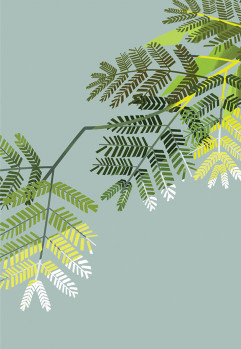DEEP ROOTS
The UAE has unveiled the official logo for the Year of Tolerance and its roots are firmly embedded in the heritage of the country.
The logo for the UAE’s Year of Tolerance has been inspired by the country’s national tree – the Ghaf.
“Tolerance is a universal value, and the Ghaf is our authentic national tree, a source of life and symbol of stability in the middle of the desert,” said His Highness Sheikh Mohammed bin Rashid Al Maktoum, Vice President and Prime Minister of the UAE and Ruler of Dubai, as he approved the official logo.
“Under its shadows our ancestors gathered to consult on matters related to their daily lives,” he added. “In the Year of Tolerance, we chose the Ghaf as a logo for all of us to live by the principles of tolerance, coexistence and diversity.”
The logo will be used by government, private and media entities in all campaigns, initiatives and programmes launched during 2019.
The Supreme National Committee of the Year of Tolerance, chaired by His Highness Sheikh Abdullah bin Zayed Al Nahyan, said that the Ghaf tree was chosen due to its great significance. The late Sheikh Zayed bin Sultan Al Nahyan, founding father of the UAE, gave great importance to the Ghaf and issued laws and regulations prohibiting the cutting of the tree throughout the country. As such, the committee said the Ghaf represented “a great cultural value in the UAE” associated with the identity and heritage of the country.
“Our ancestors and tribes gathered under the shadows of the Ghaf trees to discuss their daily matters,” said the committee. “Also, a number of UAE rulers used to meet their citizens and listen to their demands directly under the shadows of these trees.
“The Ghaf tree symbolizes stability and peace in the desert and has the ability to adapt in the desert”
“The Ghaf is planted in many countries around the world, particularly in the Middle East, Africa, Central Asia and the Americas, but under different names,” added the committee. “For us, this year, we aim to establish it as a global logo for tolerance.
” Since its formation in 1971, the UAE has been proud to promote co-existence among its multinational population. The UAE also has a long and proud history of inter-faith dialogue and freedom of religious expression, evidenced recently when His Holiness Pope Francis, the Head of the Catholic Church and Sovereign of the Vatican City, and His Eminence and Grand Iman of al-Ahar Sheikh Ahmed el-Tayeb, visited the country last month.
During the landmark visit, which marked the first time a Pontiff had visited the GCC, Pope Francis addressed a Human Fraternity Meeting at the Founder’s Memorial in Abu Dhabi. Addressing the meeting, he expressed his appreciation of the UAE’s commitment to “tolerating and guaranteeing freedom of worship”.
“The Ghaf tree symbolizes
stability and peace in the desert”
SUPREME NATIONAL COMMITTEE OF
THE YEAR OF TOLERANCE
Using the image of the “desert that surrounds us”, Pope Francis spoke of the UAE as “an important crossroads” between East and West, North and South, and praised the way the “desert has flourished” to become what he called “a place of development”.
Another example of tolerance unfolding in the UAE is the construction of the first Hindu temple in Abu Dhabi. A foundation stone-laying ceremony is set to be held on April 20. The organisation building the temple, the Bochasanwasi Akshar Purushottam Sanstha (BAPS), has confirmed that its spiritual leader, Mahant Swami Maharaj, will preside over the event.
The temple, estimated to cost AED450 million, is being built on land donated by the Abu Dhabi government during a visit by Indian Prime Minister Narendra Modi in 2016. The ground-breaking ceremony for the temple, located near Al Rahba off the Dubai-Abu Dhabi highway, was held a year ago.
The temple is being built on 55,000 square metres of land, and this year, to mark the UAE’s Year of Tolerance, the government has gifted another 55,000 sqm for parking facilities.
The structure, featuring seven spires and five ornate domes will be entirely sculpted from stone by hundreds of artisans in India. Once ready and numbered, thousands of such stone pieces will be shipped to the UAE and assembled on site like a giant 3D jigsaw puzzle. Construction is slated to begin this year.
The UAE’s art community is also celebrating the Year of Tolerance through an exhibition labelled ‘Beyond Borders’. Over 50 UAE artists representing 30 nationalities have come together for the month-long exhibition, which runs at Cassells Al Barsha Hotel, in Dubai, until 16 March.
Presented by Art4you Gallery, the tolerance exhibition – curated by Jesno Jackson, founder of Art4you gallery, and Rengi Cherian – features around 60 artworks. It was inaugurated by Yasser Algergawi, Director of Programmes and Partnership at the Ministry of Tolerance and Chairman of the Dubai Folklore Theatre.
Contributing artist Swapnil Jawale, who made a portrait of the late Sheikh Zayed using pointillism technique (using dots), said: “My artwork shows the late Sheikh Zayed, who had a natural disposition for tolerance, genuineness and concern for others.”
Describing the exhibition, Algergawi added: “Through streams of colours that form fusions of stories on canvas, with each piece telling a unique story, an environment of holistic tolerance and diversity exudes throughout the exhibit space.”








